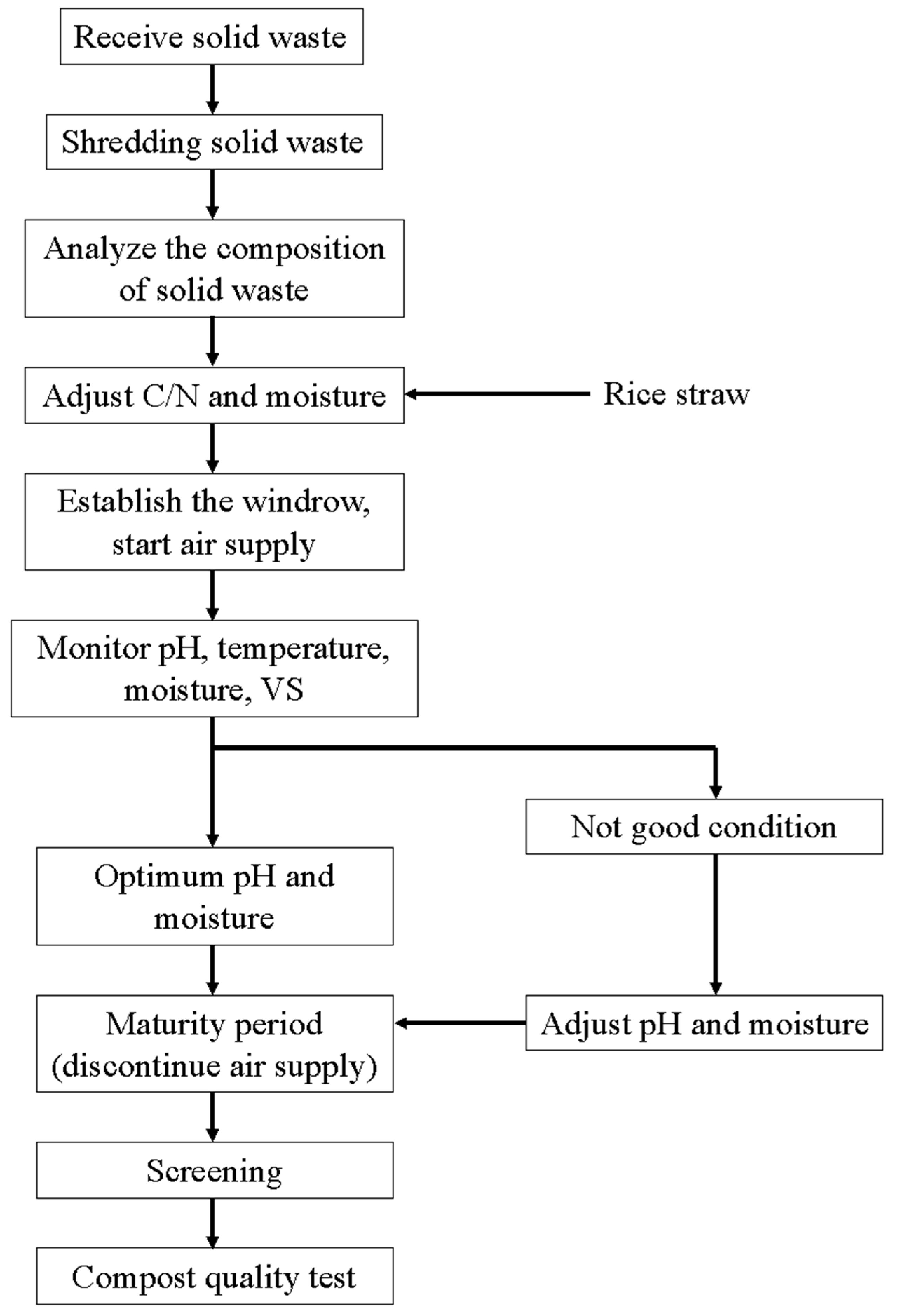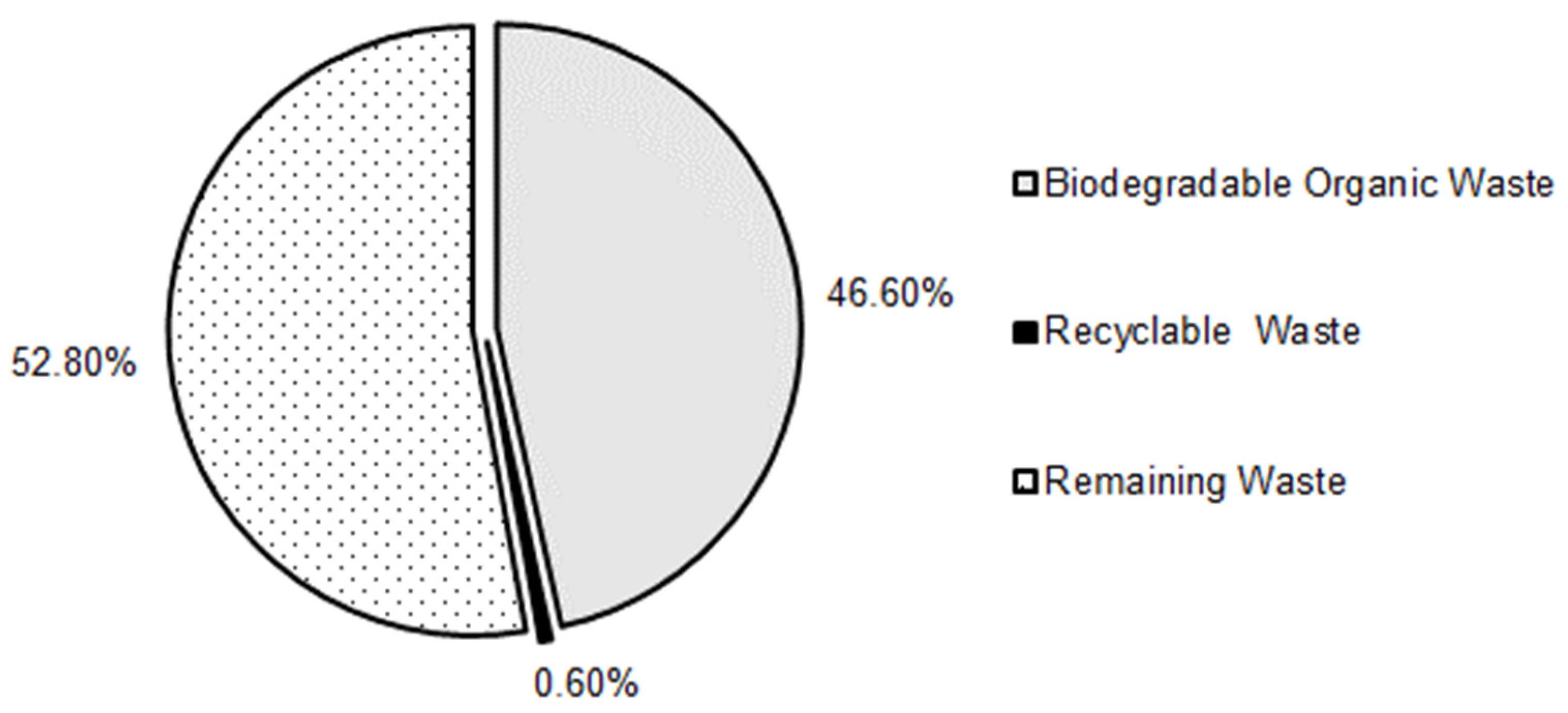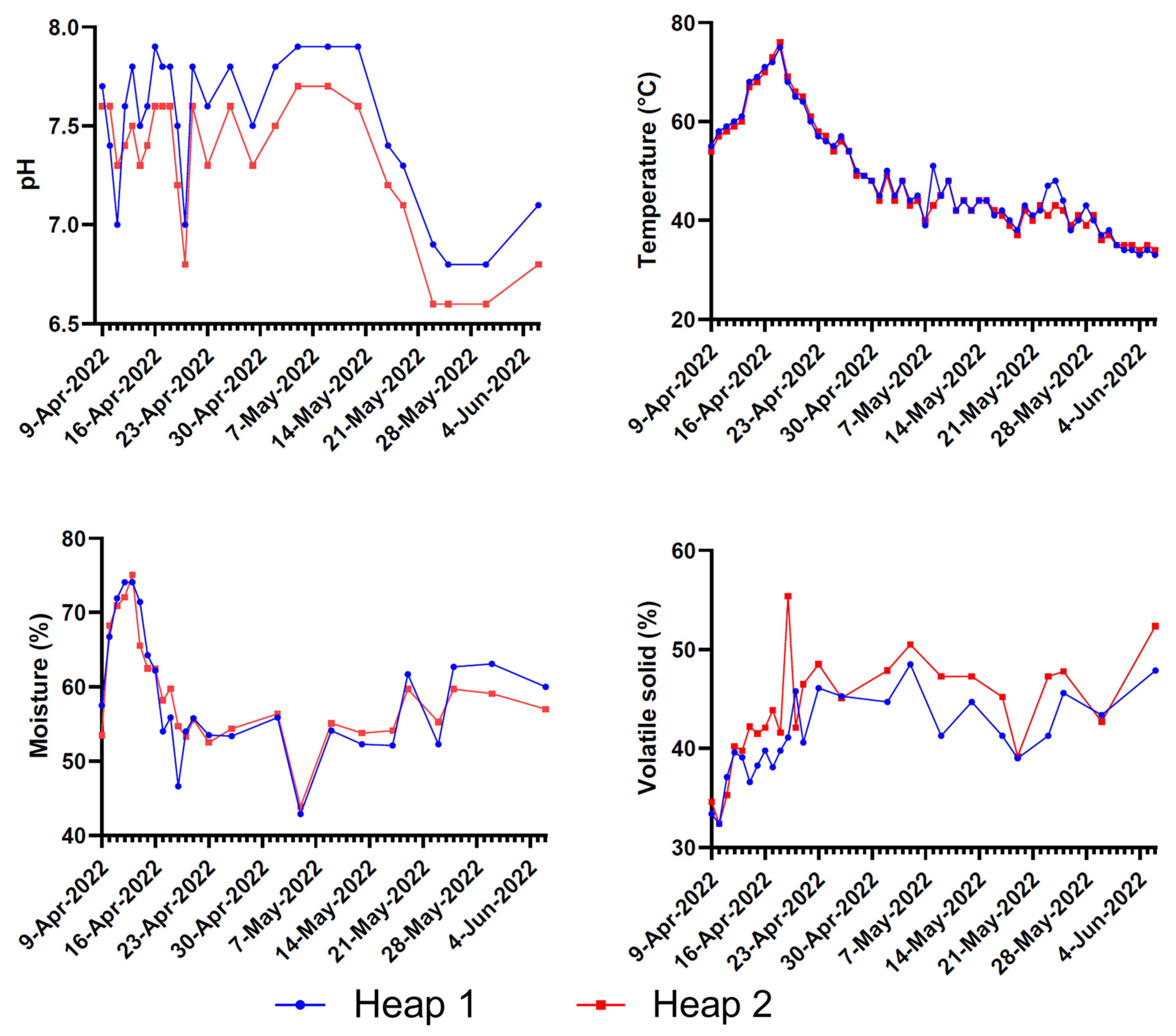Towards Sustainable Composting of Source-Separated Biodegradable Municipal Solid Waste—Insights from Long An Province, Vietnam
Abstract
:1. Introduction
2. Materials and Methods
2.1. Study Area
2.2. Materials
2.3. Active Aeration Composting
3. Results
3.1. Solid Waste Management in Tan An City, Long An Province
3.2. Quality Checking of the Separated Solid Waste
3.3. Characteristic of Separated Solid Waste
3.4. Ratio Mixing
3.5. Composting Process
3.6. Quality of Compost Products
4. Discussion
4.1. Practical Implications
4.2. Theoretical Implications
5. Conclusions
Author Contributions
Funding
Data Availability Statement
Acknowledgments
Conflicts of Interest
References
- Kaza, S.; Shrikanth, S.; Chaudhary, S. More Growth, Less Garbage; Urban Development Series; World Bank: Washington, DC, USA, 2021; Available online: http://hdl.handle.net/10986/35998 (accessed on 31 July 2022).
- Kaza, S.; Yao, L.; Bhada-Tata, P.; Van Woerden, F. What a Waste 2.0: A Global Snapshot of Solid Waste Management to 2050; World Bank Publications: Washington, DC, USA, 2018. [Google Scholar]
- Wong, Y.J.; Shimizu, Y.; He, K.; Nik Sulaiman, N.M. Comparison among different ASEAN water quality indices for the assessment of the spatial variation of surface water quality in the Selangor river basin, Malaysia. Environ. Monit. Assess. 2020, 192, 644. [Google Scholar] [CrossRef]
- Waheeb, S.A.; Zerouali, B.; Elbeltagi, A.; Alwetaishi, M.; Wong, Y.J.; Bailek, N.; AlSaggaf, A.A.; Abd Elrahman, S.I.M.; Santos, C.A.G.; Majrashi, A.A. Enhancing Sustainable Urban Planning through GIS and Multiple-Criteria Decision Analysis: A Case Study of Green Space Infrastructure in Taif Province, Saudi Arabia. Water 2023, 15, 3031. [Google Scholar] [CrossRef]
- Song, Q.; Li, J.; Zeng, X. Minimizing the increasing solid waste through zero waste strategy. J. Clean. Prod. 2015, 104, 199–210. [Google Scholar] [CrossRef]
- Sridhar, K.S. Solid Waste Management in Asia Pacific: What Explains Its Coverage? Public Work. Manag. Policy 2016, 21, 53–70. [Google Scholar] [CrossRef]
- Ministry of Natural Resources and Environment (MONRE). Report on the Current State of the National Environment in 2019—Domestic Solid Waste Management; MONRE: Ha Noi, Vietnam, 2019.
- Clarke, B.D.; Vu, C.C. EIA effectiveness in Vietnam: Key stakeholder perceptions. Heliyon 2021, 7, e06157. [Google Scholar] [CrossRef]
- Schwoob, M.H. Agriculture: An Old Issue Back on the Public Agenda. In Food Security and the Modernisation Pathway in China. Critical Studies of the Asia-Pacific; Palgrave Macmillan: Cham, Switzerland, 2018. [Google Scholar] [CrossRef]
- Asian Development Bank. Promoting Action on Plastic Pollution from Source to Sea in Asia and the Pacific: Technical Assistance Report; Asian Development Bank: Mandaluyong, Philippines, 2019. [Google Scholar]
- WWF-Vietnam. WWF-Vietnam Collaborates with Long An to Continue the Journey of ‘Waste Classification at the Source’. 2020. Available online: https://giamracnhua.vn/wwf-viet-nam-hop-tac-long-an-viet-tiep-hanh-trinh-phan-loai-rac-tai-nguon/?fbclid=IwAR1sLiE0hS_GEkiPEREOd8tngc5IKxoeVvGDK-QZf6JWpErzwu9t4-Jpqfs (accessed on 25 July 2023).
- Minh Thư. Long An: Responding to the Waste Classification Campaign at the Source. 2022. Available online: https://baotainguyenmoitruong.vn/long-an-huong-ung-chien-dich-phan-loai-rac-tai-nguon-335703.html (accessed on 25 July 2023).
- Long An Online Newspaper. Towards Segregation of Waste at Source. 2022. Available online: https://www.longan.gov.vn/Pages/TinTucChiTiet.aspx?ID=46399&InitialTabId=Ribbon.Read&PageIndex=132&fbclid=IwAR04AoDoxcG1S12VD1VQnXNNBel3lHPAnlSX060ABcVvtayCwaOKcRFd_9Q (accessed on 25 July 2023).
- Mapcorn. Long An Province Location on Map of Vietnam. Capital City Is Thu Tan An. 2023. Available online: https://www.shutterstock.com/image-vector/long-province-location-on-map-vietnam-2158948975 (accessed on 25 July 2023).
- Xu, Z.; Zhao, B.; Wang, Y.; Xiao, J.; Wang, X. Composting process and odor emission varied in windrow and trough composting system under different air humidity conditions. Bioresour. Technol. 2020, 297, 122482. [Google Scholar] [CrossRef]
- Vergara, S.E.; Silver, W.L. Greenhouse gas emissions from windrow composting of organic wastes: Patterns and emissions factors. Environ. Res. Lett. 2019, 14, 124027. [Google Scholar] [CrossRef]
- Lang, T.T.; Thao, N.T.M.; Uyen, P.V.N.; Tuan, D.A. Study on Using Biological Sludge from Vinh Loc Industrial Park to Produce Composting Product. J. Environ. Sci. Eng. A 2018, 7, 201. [Google Scholar]
- 10-TCN-526-2002; Current Status of Waste Recycling for Composting in Vietnam. MARD Vietnam, Ministry of Agriculture and Rural Development of Vietnam: Ha Noi, Vietnam, 2002.
- Ministry of Natural Resources and Environment (MONRE). Report on the State of the National Environment for the Period 2016–2020; MONRE: Ha Noi, Vietnam, 2020.
- Department of Natural Resources and Environment (DONRE). Annual Environmental Report 2019; Solid Waste Management; DONRE: Ho Chi Minh, Vietnam, 2020. [Google Scholar]
- Truong, M.T.; Nguyen, L.S.P.; Hien, T.T.; Pham, T.D.H.; Do, T.L.T. Source apportionment and risk estimation of heavy metals in PM10 at a Southern Vietnam megacity. Aerosol Air Qual. Res. 2022, 22, 220094. [Google Scholar] [CrossRef]
- Suchowska-Kisielewicz, M.; Jędrczak, A.; Myszograj, S. Kinetic constants of decomposition of the municipal solid waste prior to and after mechanical-biological processing. Field scale. Arch. Environ. Prot. 2012, 38, 71–86. [Google Scholar] [CrossRef]
- Le Thi, K.O. SURMAT Decision Support Tool to Select Municipal Solid Waste Treatment Technologies. Ph.D. Thesis, Wageningen University, Wageningen, The Netherlands, 2012. [Google Scholar]
- Tchobanoglous, G.; Theisen, H.; Vigil, S.A. Integrated Solid Waste Management: Engineering Principles and Management Issues; McGraw-Hill: New York, NY, USA, 1993. [Google Scholar]
- McKinley, V.L.; Vestal, J.R. Physical and chemical correlates of microbial activity and biomass in composting municipal sewage sludge. Appl. Environ. Microbiol. 1985, 50, 1395–1403. [Google Scholar] [CrossRef] [PubMed]
- Nguyen, T.B.; Shima, K. Composting of Sewage Sludge with a Simple Aeration Method and its Utilization as a Soil Fertilizer. Environ. Manag. 2019, 63, 455–465. [Google Scholar] [CrossRef] [PubMed]
- Aguilar-Paredes, A.; Valdés, G.; Araneda, N.; Valdebenito, E.; Hansen, F.; Nuti, M. Microbial Community in the Composting Process and Its Positive Impact on the Soil Biota in Sustainable Agriculture. Agronomy 2023, 13, 542. [Google Scholar] [CrossRef]
- Golueke, C.G. Composting: A Study of the Process and Its Principles; Rodale Press: Ephrata, PA, USA, 1972. [Google Scholar]
- Gajalakshmi, S.; Abbasi, S.A. Solid waste management by composting: State of the art. Crit. Rev. Environ. Sci. Technol. 2008, 38, 311–400. [Google Scholar] [CrossRef]
- Waldron, K.W.; Nichols, E. Composting of food-chain waste for agricultural and horticultural use. In Handbook of Waste Management and Co-Product Recovery in Food Processing; Woodhead Publishing: Cambridge, UK, 2009; pp. 583–627. [Google Scholar]
- Verma, R.; Badole, W.P.; Deewan, P.; Meena, V.S. Carbon and weight loss during composting of wheat straw by different methods. Ann. Biol. 2014, 30, 354–357. [Google Scholar]
- Tiquia, S.M.; Richard, T.L.; Honeyman, M.S. Carbon, nutrient, and mass loss during composting. Nutr. Cycl. Agroecosyst. 2002, 62, 15–24. [Google Scholar] [CrossRef]
- US Composting Council. Test Methods for the Examination of Composting and Compost; Wayne Thompson: Lexington, KY, USA, 2002. [Google Scholar]
- Waste and Resources Action Programme. Quality Protocol Compost. The Quality Protocol for the Production and Uses of Quality Compost from Source-Segregated Biodegradable Waste; Environment Agency: London, UK, 2007.
- Jimenez, E.I.; García, V.P. Determination of maturity indices for city refuse composts. Agric. Ecosyst. Environ. 1992, 38, 331–343. [Google Scholar] [CrossRef]
- Casale, W.L.; Minassian, V.; Menge, J.A.; Lovatt, C.J.; Pond, E.; Johnson, E.; Guillermet, F. Urban and agricultural wastes for use as mulches on avocado and citrus and delivery of microbial agents. J. Hortic. Sci. 1995, 70, 315–322. [Google Scholar] [CrossRef]
- Smith, S.R. A critical review of the bioavailability and impacts of heavy metals in municipal solid waste composts compared to sewage sludge. Environ. Int. 2009, 35, 142–156. [Google Scholar] [CrossRef]
- Haug, R.T. The Practical Handbook of Compost Engineering; Routledge: London, UK, 2018. [Google Scholar]
- ENV.A.2./ETU/2001/0024; Heavy Metals and Organic Compounds from Wastes Used as Organic Fertilisers. European Commission: Brussels, Belgium, 2004.
- Sharma, V.K.; Canditelli, M.; Fortuna, F.; Cornacchia, G. Processing of urban and agro-industrial residues by aerobic composting: Review. Energy Convers. Manag. 1997, 38, 453–478. [Google Scholar] [CrossRef]
- Th, M. Long An: Launching the Waste Classification at Source Model for Rural Areas. 2022. Available online: https://baotainguyenmoitruong.vn/long-an-phat-dong-mo-hinh-phan-loai-rac-tai-nguon-cho-khu-vuc-nong-thon-361291.html (accessed on 28 June 2023).
- Rehman, S.; De Castro, F.; Aprile, A.; Benedetti, M.; Fanizzi, F.P. Vermicompost: Enhancing Plant Growth and Combating Abiotic and Biotic Stress. Agronomy 2023, 13, 1134. [Google Scholar] [CrossRef]
- General Statistic Office (GSO). Statistical Yearbook 2020; Statistical Publisher House: Ha Noi, Vietnam, 2021. [Google Scholar]
- Nordahl, S.L.; Preble, C.V.; Kirchstetter, T.W.; Scown, C.D. Greenhouse Gas and Air Pollutant Emissions from Composting. Environ. Sci. Technol. 2023, 57, 2235–2247. [Google Scholar] [CrossRef] [PubMed]






| No. | Parameter | Unit | This Study (n = 5) | Rice Straw (n = 1) | Previous Study [13] | Optimal Conditions [17] |
|---|---|---|---|---|---|---|
| 1 | pH | - | 8.7 ± 0.4 | 7.2 | 5.9 ± 0.3 | 6.0–7.5 |
| 2 | Moisture | % | 76.8 ± 1.6 | 6.5 | 80.9 ± 3 | 50–60 |
| 3 | VS | % | 68.3 ± 1.1 | 90.5 | 86.2 ± 3.8 | - |
| 4 | T-N | % | 2.1 ± 0.1 | 0.8 | - | - |
| 5 | TOC | % | 35.7 ± 1.9 | 39.9 | - | - |
| 6 | C/N | - | 17 ± 0.8 | 49.9 | 28.4 ± 0.4 | 25–35 |
| No. | Parameter | Unit | Compost Quality (n = 4) | Vietnam Standard 10TCN 526:2002 | United States Standard TMECC [33] | European Union Standard QP Compost [34] |
|---|---|---|---|---|---|---|
| 1 | pH | - | 7.6 ± 0.2 | 6.0–8.0 | 6.0–8.0 | 5.5–8.0 |
| 2 | Moisture | % | 52.5 ± 0.8 | <than 35% | 40–60% | 30–60% |
| 3 | T-N | % | 2.2 ± 0.1 | Not less than 2.5% | 1.0–3.0% | 1.0–4.0% |
| 4 | P2O5 | % | 1.2 ± 0.1 | Not less than 2.5% | 0.5–3.0% | 0.4–4.0% |
| 5 | K2O | % | 2.8 ± 0.1 | Not less than 1.5% | 0.5–3.0% | 0.2–3.5% |
| 6 | TOC | % | 26.6 ± 2.7 | Not less than 13% | - | - |
| 7 | Cu | mg/kg DW | 38.7 ± 6.6 | <200 mg/kg | <1500 mg/kg | 70–1000 mg/kg |
| 8 | Cd (LOD = 0.3) | mg/kg DW | N.D. | <2.5 mg/kg | <39 mg/kg | 0.7–10 mg/kg |
| 9 | Cr | mg/kg DW | 13.3 ± 1.6 | <than 200 mg/kg | <1200 mg/kg | 70–200 mg/kg |
| 10 | Ni | mg/kg DW | 7.6 ± 0.4 | <than 100 mg/kg | <420 mg/kg | 20–200 mg/kg |
| 11 | Pb | mg/kg DW | 12 ± 1.8 | <than 250 mg/kg | <300 mg/kg | 70–1000 mg |
| 12 | Zn | mg/kg DW | 135.5 ± 7.5 | <than 750 mg/kg | <2800 mg/kg | 210–4000 mg |
| 13 | Hg | mg/kg DW | 0.5 ± 0.03 | <than 2 mg/kg | <17 mg/kg | 0.7–10 mg/kg |
| 14 | Number of microorganisms | CFU/g | 1.2 ± 0.3 × 107 | less than 106 | No specific standard, but microbial activity is often measured | No specific standard, but microbial presence is expected |
| 15 | Salmonella | CFU/g | N.D | N.D | N.D | N.D |
| 16 | Particle size (pass through 2mm sieve) | % | 33.6 ± 3 | <4–5 mm | 2–5 mm | 2–5 mm |
| 17 | Particle size (pass through 5 mm sieve) | % | 100 | <4–5 mm | 2–5 mm | 2–5 mm |
| No. | Parameter | Unit | Compost Quality (n = 4) | Previous Studies |
|---|---|---|---|---|
| 1 | Cu | mg/kg DM | 38.7 ± 6.6 | 150–300 * |
| 2 | Cd (LOD = 0.3) | mg/kg DM | N.D. | 2.00–4.00 * |
| 3 | Cr | mg/kg DM | 13.3 ± 1.6 | 80–100 * |
| 4 | Ni | mg/kg DM | 7.6 ± 0.4 | 40–50 * |
| 5 | Pb | mg/kg DM | 12 ± 1.8 | 250–350 * |
| 6 | Zn | mg/kg DM | 135.5 ± 7.5 | 300–655 * |
| 7 | Hg | mg/kg DM | 0.5 ± 0.03 | N.D.–0.63 ** 0.02–1.9 *** |
Disclaimer/Publisher’s Note: The statements, opinions and data contained in all publications are solely those of the individual author(s) and contributor(s) and not of MDPI and/or the editor(s). MDPI and/or the editor(s) disclaim responsibility for any injury to people or property resulting from any ideas, methods, instructions or products referred to in the content. |
© 2023 by the authors. Licensee MDPI, Basel, Switzerland. This article is an open access article distributed under the terms and conditions of the Creative Commons Attribution (CC BY) license (https://creativecommons.org/licenses/by/4.0/).
Share and Cite
Huynh, T.L.; Le, T.K.O.; Wong, Y.J.; Phan, C.T.; Trinh, T.L. Towards Sustainable Composting of Source-Separated Biodegradable Municipal Solid Waste—Insights from Long An Province, Vietnam. Sustainability 2023, 15, 13243. https://doi.org/10.3390/su151713243
Huynh TL, Le TKO, Wong YJ, Phan CT, Trinh TL. Towards Sustainable Composting of Source-Separated Biodegradable Municipal Solid Waste—Insights from Long An Province, Vietnam. Sustainability. 2023; 15(17):13243. https://doi.org/10.3390/su151713243
Chicago/Turabian StyleHuynh, Tan Loi, Thi Kim Oanh Le, Yong Jie Wong, Chi Tuong Phan, and Thi Long Trinh. 2023. "Towards Sustainable Composting of Source-Separated Biodegradable Municipal Solid Waste—Insights from Long An Province, Vietnam" Sustainability 15, no. 17: 13243. https://doi.org/10.3390/su151713243
APA StyleHuynh, T. L., Le, T. K. O., Wong, Y. J., Phan, C. T., & Trinh, T. L. (2023). Towards Sustainable Composting of Source-Separated Biodegradable Municipal Solid Waste—Insights from Long An Province, Vietnam. Sustainability, 15(17), 13243. https://doi.org/10.3390/su151713243







